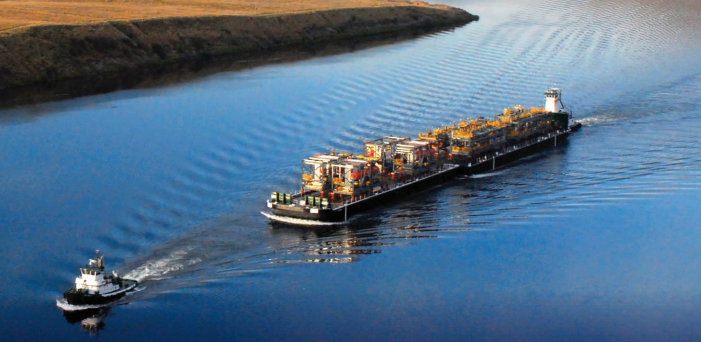The US Coast Guard issued two policy letters providing updated guidance for Officers in Charge, Marine Inspection with respect to harbor assist towing beyond the boundary line and use of doublers on Subchapter M towing vessels.
USCG Office of Commercial Vessel Compliance published Policy Letter 19-01 Change 1 “Enforcement Guidance for Harbor Assist Towing Vessels When Operating Beyond the Boundary Line” to align with the National Defense Authorization Act for Fiscal Year 2021.
The policy letter provides updated enforcement guidance to the Coast Guard Officers in Charge, Marine Inspection (OCMI) regarding changes to manning, credentialing, and watchkeeping requirements, applicable to harbor assist towing vessels inspected under 46 Code of Federal Regulations (CFR) Subchapter M that travel outside the Boundary Line.
To facilitate effective waterways management while mitigating safety concerns, harbor assist towing vessels have been transiting further from the port to meet vessels, and may, as a result be required to cross the Boundary Line.
[smlsubform prepend=”GET THE SAFETY4SEA IN YOUR INBOX!” showname=false emailtxt=”” emailholder=”Enter your email address” showsubmit=true submittxt=”Submit” jsthanks=false thankyou=”Thank you for subscribing to our mailing list”]
Towing vessels inspected under Title 46 CFR Subchapter M receive a Certificate of Inspection (COI) that clearly defines the routes and conditions a vessel may operate upon along with manning and credentialing requirements. The OCMI specifies the minimum manning complement necessary for the safe operation of the vessel after considering applicable laws, regulations, and all other factors involved such as size and type of the vessel, installed equipment, and proposed routes of operation.
On January 1, 2021, Congress included Section 8402 to the NDAA, which addresses Towing Vessels Operating outside the Boundary Line.
OCMIs and MIs shall apply this policy letter to regulatory requirements for harbor assist towing vessels that may not meet certain manning, credentialing, and watchkeeping requirements as they apply to inspected vessels operating outside the Boundary Line. In addition, Change 1 stipulates notification requirements for the interim period of the law.
There is an interim exemption for towing vessels that operate outside the Boundary Line solely to perform regular harbor assist operations. Under this interim exemption, certain towing vessels are not required to meet additional requirements of Chapter I of Title 33 and Chapter I of Title 46, Code of Federal Regulations that would result solely from the vessel operating outside the Boundary Line.
- The interim exemption applies to: A towing vessel that would otherwise be subject to chapter 33 of title 46 USC and 46 CFR Subchapter M; and
- Operates with only “Lakes, Bays, and Sounds” or “River” routes recorded on the COI; and
- Operates regularly as a harbor assist vessel and is regularly engaged in harbor assist operations, which includes docking, undocking, mooring, unmooring, and escorting of vessels with limited maneuverability.
- The voyage of the harbor assist towing vessel shall be limited to:
(1) Less than 12 hours in total duration;
(2) Originate and end in the inspection zone of a single OCMI; and
(3) Occur no further than 10 nautical miles from the Boundary Line.
FIND USCG POLICY LETTER 19-01 CHANGE 1 HERE
In addition, the Office of Commercial Vessel Compliance issued Policy Letter 21-03 “Guidance Concerning the Use of Doubler Plates for Repairs Involving Towing Vessels Subject to 46 CFR Subchapter M” to provide guidance to Officers in Charge, Marine Inspection, the Towing Vessel National Center of Expertise (TVNCOE), and 46 CFR Chapter I, Subchapter M Third Party Organizations on the use of doubler plates for repairs involving towing vessels subject to inspection under 46 CFR Subchapter M.
OCMIs, TVNCOE, and TPOs should refer to this Policy Letter when a towing vessel owner, managing operator, or other person with interest in the vessel seeks to use a doubler plate to make repairs to a towing vessel constructed of steel.
OCMIs, TVNCOE, and TPOs should use the following guidance, (in addition to Navigation and Vessel Inspection Circular (NVIC) No. 7-68) when repairs involving doubler plates are used on steel hull towing vessels:
a. New doubler plates should not be permitted for permanent repairs except for allowances in NVIC No. 7-68. Examples, where doublers may be approved as permanent repairs, include:
- wastage doublers used in non-strength areas to restore watertight integrity;
- local reinforcement at overboard discharges or seachests;
- keel cooler doublers that do not extend beyond the keel cooler;
- wear plates above propellers; and
- on sound plating in areas highly susceptible to corrosion as a means for protection.
b. New doubler plate installations.
i. New Doubler Plates as Temporary Repairs. After evaluation by the OCMI or an appropriately qualified TPO surveyor, doubler plates may be authorized for temporary repairs in limited circumstances. This evaluation may be limited to the effectiveness of the doubler at restoring watertight integrity and a visual inspection, if possible, to assess the doubler fit up and condition. Doubler plates used for temporary repairs should be removed as soon as possible, but no later than at the next drydock, unless the OCMI or TPO requires permanent repairs to be completed earlier.
ii. New Doubler Plates as Permanent Repairs. An MI or an appropriately qualified TPO surveyor should visually inspect all new doubler plate repairs for workmanship and verify the doubler plate is free of sharp edges, burrs, carburized flame cut material, and weld spatter. If an onsite inspection of the doubler plate repair is not possible, then the MI or appropriately qualified TPO surveyor may accept documentation suitable to ascertain workmanship and finish such as photographs, non-destructive testing reports or other objective evidence suitable to the Coast Guard. The doubler plate should be sand or shot blasted to remove rust and scale prior to this inspection. After obtaining MI or TPO approval, the doubler plate repair must be given a complete coat of primer and topcoat based on the environment and compatibility with coatings on the existing structure. For a new doubler plate repair to be deemed permanent, at a minimum, a certified nondestructive testing Level II inspector should inspect the welds involved in the installation of the doubler plate and provide a report to the TPO or the cognizant OCMI.
c. Existing Doubler Plate Repairs: At this time, existing doublers may remain on steel hulled towing vessels. However, OCMIs and TPOs may require existing doublers to be removed if the fit up and installation is not acceptable or creates an unsafe condition. CG-CVC will coordinate with the Traveling Marine Inspectors and specific units to collect data on the adequacy of existing double plates for potential future policy development.






























































